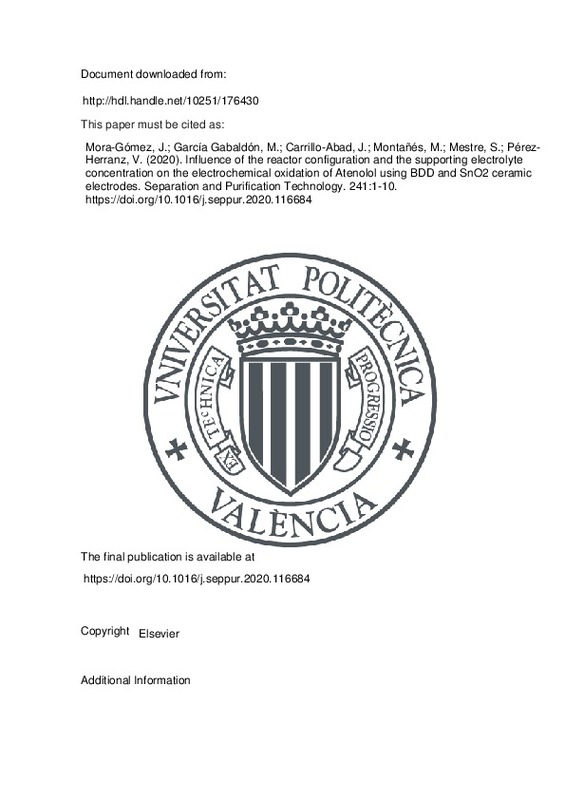JavaScript is disabled for your browser. Some features of this site may not work without it.
Buscar en RiuNet
Listar
Mi cuenta
Estadísticas
Ayuda RiuNet
Admin. UPV
Influence of the reactor configuration and the supporting electrolyte concentration on the electrochemical oxidation of Atenolol using BDD and SnO2 ceramic electrodes
Mostrar el registro sencillo del ítem
Ficheros en el ítem
| dc.contributor.author | Mora-Gómez, Julia
|
es_ES |
| dc.contributor.author | García Gabaldón, Montserrat
|
es_ES |
| dc.contributor.author | Carrillo-Abad, Jordi
|
es_ES |
| dc.contributor.author | Montañés, Maria-Teresa
|
es_ES |
| dc.contributor.author | Mestre, S.
|
es_ES |
| dc.contributor.author | Pérez-Herranz, Valentín
|
es_ES |
| dc.date.accessioned | 2021-11-05T14:10:46Z | |
| dc.date.available | 2021-11-05T14:10:46Z | |
| dc.date.issued | 2020-06-15 | es_ES |
| dc.identifier.issn | 1383-5866 | es_ES |
| dc.identifier.uri | http://hdl.handle.net/10251/176430 | |
| dc.description.abstract | [EN] Electrochemical oxidation of ß-blocker atenolol (ATL, 100 ppm) at different applied current densities (33, 50 and 83 mA·cm-2) using a reactor divided by an ion-exchange membrane and an undivided one was investigated. Two types of anodes were used for this purpose: a boron-doped diamond (BDD) anode and new low-cost ceramic electrodes made of tin dioxide doped with antimony (Sb-doped SnO2). Degradation was assessed using a high performance liquid chromatography, while mineralization by measuring total organic carbon (TOC) dissolved in sample. Except for the lowest current density, ATL was completely degraded for both reactors and electrodes. The highest percentage of TOC eliminated (89%) was obtained at the highest applied current density with the BDD electrode in the divided reactor. The presence of the cation-exchange membrane prevented the reduction of both the electrogenerated oxidizing species and the oxidized organic compounds and enhances the electro-oxidation kinetic reaction. In order to study the influence of the supporting electrolyte, three different concentrations of sodium sulfate (0.014, 0.05 and 0.1 M) were tested in the undivided reactor with both electrodes. The results showed that an increase in the concentration of the supporting electrolyte improves the mineralization of ATL for the BDD electrode and, on the contrary, worsens for the ceramic electrode. Accelerated service life tests were carried out for the ceramic electrode at 100 mA·cm-2 in 0.5 M H2SO4. Ecotoxicity tests using marine bacteria (Vibrio Fischeri) revealed that no toxic by-products were formed in any case. | es_ES |
| dc.description.sponsorship | The authors thank the financial support from the Ministerio de Economia y Competitividad (Spain) under the project RTI2018-101341-B-C21, co-financed with FEDER funds. | es_ES |
| dc.language | Inglés | es_ES |
| dc.publisher | Elsevier | es_ES |
| dc.relation.ispartof | Separation and Purification Technology | es_ES |
| dc.rights | Reconocimiento - No comercial - Sin obra derivada (by-nc-nd) | es_ES |
| dc.subject | Atenolol | es_ES |
| dc.subject | BDD anode | es_ES |
| dc.subject | Electrochemical oxidation | es_ES |
| dc.subject | Sb-doped SnO2 ceramic anode | es_ES |
| dc.subject | Accelerated service life test | es_ES |
| dc.subject | Toxicity | es_ES |
| dc.subject.classification | INGENIERIA QUIMICA | es_ES |
| dc.title | Influence of the reactor configuration and the supporting electrolyte concentration on the electrochemical oxidation of Atenolol using BDD and SnO2 ceramic electrodes | es_ES |
| dc.type | Artículo | es_ES |
| dc.identifier.doi | 10.1016/j.seppur.2020.116684 | es_ES |
| dc.relation.projectID | info:eu-repo/grantAgreement/AEI/Plan Estatal de Investigación Científica y Técnica y de Innovación 2017-2020/RTI2018-101341-B-C21/ES/ELECTROCHEMICAL CHARACTERIZATION OF CERAMIC ELECTRODES AND MEMBRANES AND APPLICATION TO PHOTOELECTROOXIDATION AND ELECTROFILTRATION PROCESSES/ | es_ES |
| dc.rights.accessRights | Abierto | es_ES |
| dc.contributor.affiliation | Universitat Politècnica de València. Departamento de Ingeniería Química y Nuclear - Departament d'Enginyeria Química i Nuclear | es_ES |
| dc.description.bibliographicCitation | Mora-Gómez, J.; García Gabaldón, M.; Carrillo-Abad, J.; Montañés, M.; Mestre, S.; Pérez-Herranz, V. (2020). Influence of the reactor configuration and the supporting electrolyte concentration on the electrochemical oxidation of Atenolol using BDD and SnO2 ceramic electrodes. Separation and Purification Technology. 241:1-10. https://doi.org/10.1016/j.seppur.2020.116684 | es_ES |
| dc.description.accrualMethod | S | es_ES |
| dc.relation.publisherversion | https://doi.org/10.1016/j.seppur.2020.116684 | es_ES |
| dc.description.upvformatpinicio | 1 | es_ES |
| dc.description.upvformatpfin | 10 | es_ES |
| dc.type.version | info:eu-repo/semantics/publishedVersion | es_ES |
| dc.description.volume | 241 | es_ES |
| dc.relation.pasarela | S\417893 | es_ES |
| dc.contributor.funder | AGENCIA ESTATAL DE INVESTIGACION | es_ES |
| dc.contributor.funder | European Regional Development Fund | es_ES |
| dc.subject.ods | 06.- Garantizar la disponibilidad y la gestión sostenible del agua y el saneamiento para todos | es_ES |







![[Cerrado]](/themes/UPV/images/candado.png)

